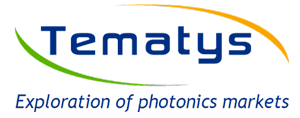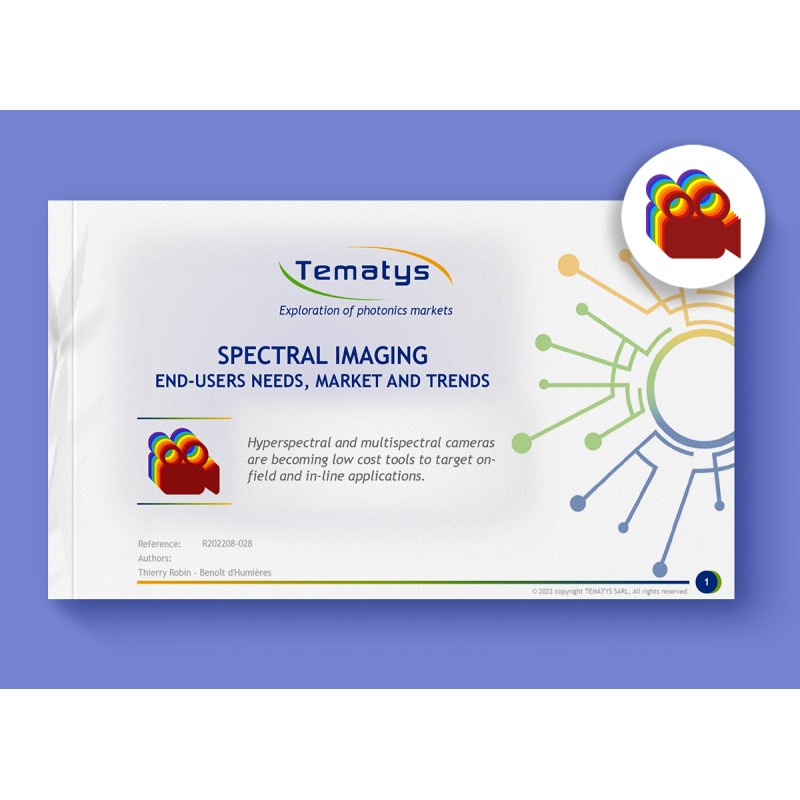Spectral Imaging: End-user needs, Markets and Trends (2022)
Hyperspectral and multispectral cameras are becoming low cost tools to target on-field and in-line applications.
See the flyer
Objectives of the report
- Underline how spectral imaging can address key economical and societal challenges,
- Provide market data and forecast of spectral imaging cameras by application and by spectral band,
- Describe and benchmark the numerous hyperspectral and multispectral available technologies,
- Identify the most promising applications of hyperspectral and multispectral cameras,
- Highlight the importance of data processing in the development of the spectral imaging market,
- Understand end-users requirements for each Application, and the challenges to overcome for a wider adoption of spectral imaging.
Report outline
- Title: Spectral Imaging: End-user needs, Market and trends - 202
- 200 + slides
- € 4 990 – Multi users license
Key Features of the report
- Market revenue breakdown between multispectral and hyperspectral cameras
- Spectral imaging cameras market forecast by applications
- Benchmarking of different spectral imaging technologies
- Analysis of most promising applications
Related Reports
- Miniature and Micro Spectrometers: End-user needs, Market and trends
- Infrared Imaging Photodetectors and Systems
A market at a turning point
First introduced for earth observation from satellites and planes, spectral imaging (including hyperspectral and multispectral imaging) was adopted in industry in the 2000's, for sorting applications. Sorting is currently the biggest market of multispectral and hyperspectral cameras, in revenue.
The adoption in other industrial or in on-field applications remained low for three main reasons: the high cost of cameras, their large size and the huge amount of data to process and store. Currently, the spectral imaging market is at a turning point in its evolution. Technical efforts have been made to build cameras at cost below $10,000 and compact enough to be implemented on drones or in industrial lines. Meanwhile, robust and user-friendly methods for spectral data analysis have been developed. These achievements will lead to a wider adoption of multi/hyperspectral cameras for on-field or in-line applications. The spectral imaging market is expected to experience a high annual growth rate of around 20% in the coming years, reaching more than 10 000 cameras sold in 2024 (excluding the Space and Military markets).
The report provides the breakdown between multispectral and hyperspectral cameras. It also includes detailed market revenue and units forecasts by application and detailed analysis by market segment.
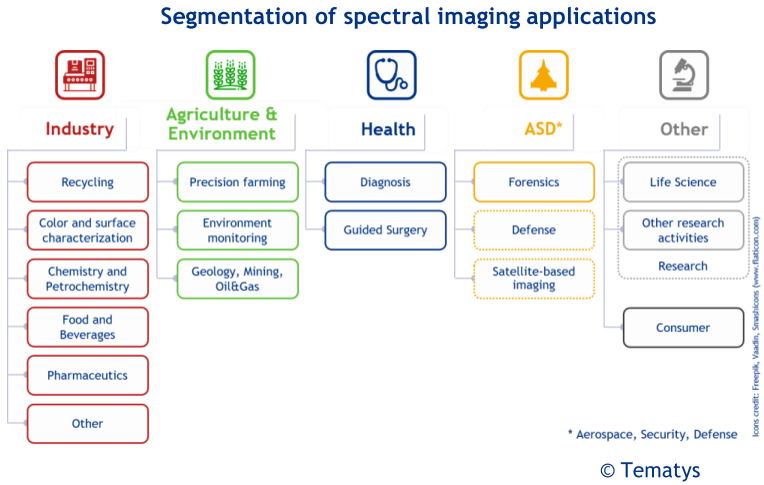
A market driven by societal challenges
With its ability to combine spatial and chemical information, spectral imaging addresses 3 major industrial and societal challenges:
- The deployment of industry 4.0, which induces a high demand for cost-effective smart sensors able to provide complex measurements,
- The need for sustainable and safe food production, which requires measurements on large areas and at high throughput to provide high food quality for an ever growing population,
- The development of personalized healthcare, that implies the need of label-free, non invasive and compact tools, giving a fast and reliable diagnosis.
These demands for low cost advanced analysis will drive the adoption of hyperspectral and multispectral cameras into on-field and in-line applications markets that will experience a high growth are Food & Beverages, Precision Agriculture, Color and Surface Characterization, Gas sensing, Pharmaceutics QA/QC, and Medical applications in the long-term.
In this report, we provide a detailed analysis of current and most promising applications of spectral imaging cameras. We describe the end-users needs and the remaining challenge for their widespread adoption in these markets.
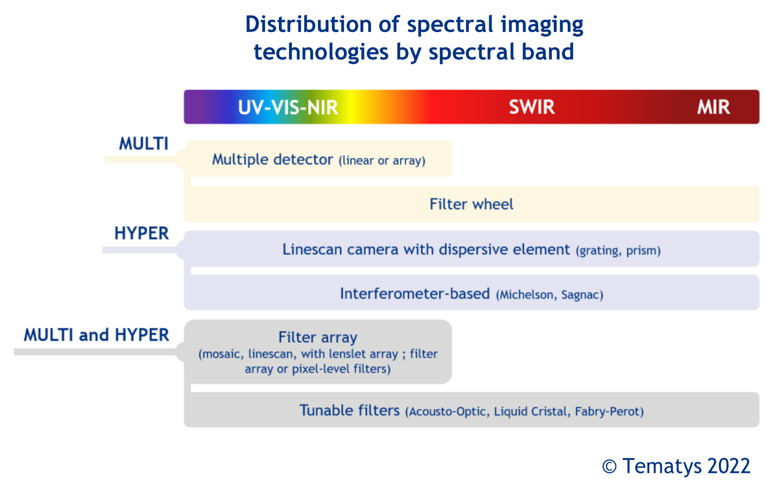
Technology developments meet the demand for low cost advanced analysis
In on-field and industrial applications, the demand for low cost portable and easy-to-use systems is high. Technological breakthroughs are undertaken at hardware and software levels to decrease cost and size of spectral imaging cameras and simplify the data processing methods.
Recent advances take advantage of innovative technologies like deposition of filters on CMOS detectors at wafer level or innovative designs of cameras
integrating multiple detector arrays.
With these technologies, cameras currently reach cost of $5 000 to $12 000. Further progresses are necessary to achieve the target price of $1 000 to $5 000 for broad adoption on field or in industry.
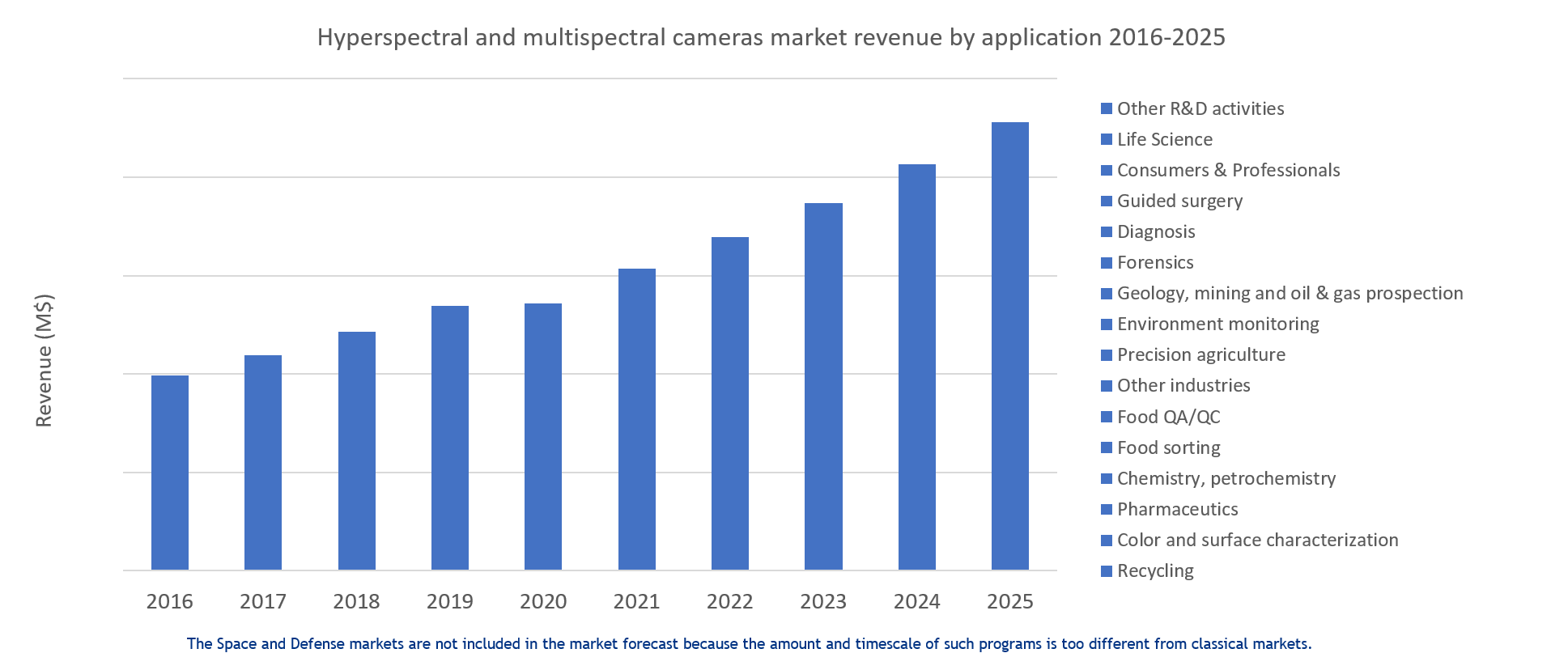
Table of contents
Executive Summary
Introduction
- Study goals and objectives
- Information sources and methodology
- Glossary
- Context and Definitions
- Scope of the report
- List of companies
Highlights of the report
A market at a turning point
- Driver: demand for advanced analysis at lower cost
- Value chain and market definition
- Market players 2022
- Market data and forecasts 2017-2025
- Market analysis and remaining challenges
Hardware and software technology trends
- Introduction
- Segmentation of commercial technologies
- Multispectral imaging technologies:
- Spatial scanning
- Snapshot
- Spectral scanning
- Hyperspectral imaging technologies:
- Spatial scanning
- Snapshot
- Spectral scanning
- Technologies and cameras cost by spectral bands
- Data processing layers: towards application-oriented solutions
Spectral imaging current status and promosing applications
- Current status
- Next big markets to be addressed
- Industry 4.0 (Color and surface characterization, Pharmaceutics)
- Sustainable food production and food safety (Precision farming, food sorting and Food quality control)
- Personalized Health (Medical diagnosis and guided-surgery)
Appendices
- Methodology
- About TEMATYS
TEMATYS Spectral imaging Flyer 2022

